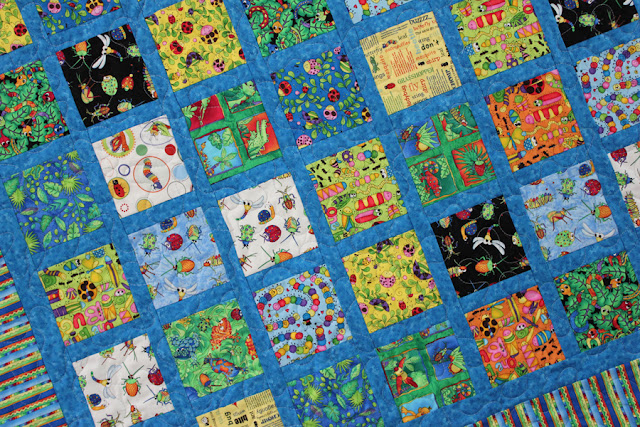As a mom I’m always looking for ways to keep my home clean and organized and kids toys have always stumped me. I’d organize their toys and then get frustrated when they didn’t put things back where I assigned. Guess I’m a little too organized, but the thought of a “toy box”, a free for all dumping ground for toys makes me break out in a rash. Anybody else? This is my solution- A toy bag that converts to a play mat and then back to a storage bag. Since making this one for brick building blocks (aka Legos), I thought this could work for so many other toys; especially ones with small pieces. You could even make small individual play mats, 18x18” would be a perfect fun size. Constructing it would be the same just smaller measurements. I’ll have to play with that and then let you know, on with the tutorial-

Toy Bag & Play Mat Tutorial
by
Trisha Weekes
Supplies Needed:
42-44” of 2 Fabrics (depends on your WOF (width of fabric) without selvedges) Measure that, and then get that amount in inches, LOF (length of fabric).
1/3 yard of fabric for drawstring casing
4 yards of 3/8” Cording
4 2/3 yards of Fusible interfacing for light weight fabrics (or less if you only want it on the liner fabric)
Step 1-
Square up the fabrics and remove the selvedge from all fabrics.
Next, we’ll iron on the fusible interfacing to the fabrics designated for the bag body.
*Note- I decided to apply the fusible interfacing because the bricks have sharp corners and I thought it wouldn’t take long to wear a hole in the fabrics. You can apply it to only the liner fabric or go without entirely, it’s up to you. Also the interfacing isn’t as wide as the fabrics even doubled, so it’s still a good inch or two shorter. I’d make sure my interfacing matched in the middle instead of on the sides of the fabrics. (As shown in the photo)
Step 2-
Now we’re going to cut out our circles for the bags. The way I decided to do this step was, fold the fabric into fourths, pin a string to the folded corner and take a string to the edge parallel to it. I marked the string; you can cut if that works for you, I didn’t want to cut this string because it was for another project. Then I took my fabric pencil and held it to that mark on the string and then guided it from corner to corner, allowing the pencil to drag on the fabric. I did have to hold the corner with the pinned string, pull the string tautly with the other, and then proceed to make the mark. This worked for me; any other suggestions for this step are welcome. Then cut on the line made by the pencil.
My circles ended up being 42” round. I cut out the first one and then just laid it on top of the other folded square to make sure they were the right size.
Step 3-
To make the casing for the drawstring, cut up the third of a yard of fabric into 3” strips, you should get 4 strips out of the third yard of fabric. Remove the selvedges, if you haven’t already.
Then sew the strips end to end. Once that’s done, quickly measure the full circle by laying the strips on the circumference of circle and then cutting the strip to fit the circle.
Turn a ¼” hem on each of the short ends.
Then fold in half lengthwise and sew a 1/4” seam the length of the casing.
Step 4-
Pin casing to liner fabric, sew using a ¼” seam. (You will have a 1” gap on the casing, but this is fine and needed for the drawstring to work properly.)
Then lay the two circles on top of each other, line them up and pin- right sides together.
Sew a ¼” seam all around both circles, leaving a 10-12” opening for turning, opposite the opening for the drawstring.
Step 5-
Sew closed the opening used for turning the fabrics.
Pin, then topstitch close to the edge, all around finishing the body of the bag.
Step 6- (is optional but highly recommended)
Sew on the folded lines of both circles, from edge to edge, making the 2 pieces a united whole. That way when you wash the bag shifting will not be an issue.
Step 7-
Thread the drawstring through the casing, starting at one end and going full circle until you come out the other opening. To do this I attach a large safety pin to the string and guide it through the casing gathering it up as I go.
Step 8-
Make a knot in the drawstring and be finished! Or…
I made a little tag, inserted the ends and sewed the tag closed. I went back and forth a few times to ensure the string would not come out. It’s your choice. I like finishing details that make handmade items look like retail items. The tag sews like this: take a 3x3.5” piece from the strips used for the casing. Make a ¼” hem on the longer end, then fold in half and sew a seam down the side and bottom. Trim thread and corners, then turn right side out. Insert ends of string into tag and sew the tag closed.
I hope this tutorial will help you with some of your toy frustrations; it’s certainly made a difference with mine! I love how the drawstring acts as a barrier to runaway toys while in play.
It’s so easy to clean-up, here is my four ye
ar old closing up the bag!





































